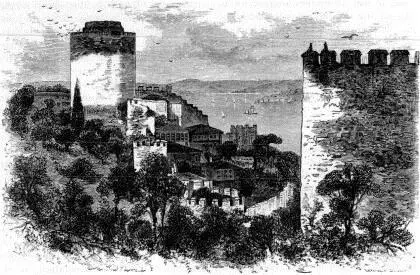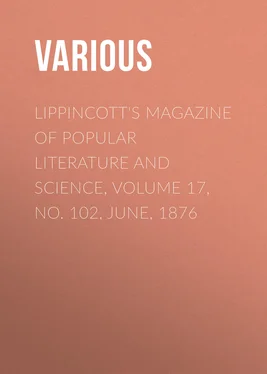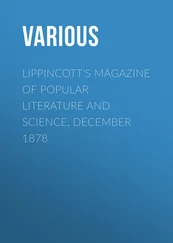Various - Lippincott's Magazine of Popular Literature and Science, Volume 17, No. 102, June, 1876
Здесь есть возможность читать онлайн «Various - Lippincott's Magazine of Popular Literature and Science, Volume 17, No. 102, June, 1876» — ознакомительный отрывок электронной книги совершенно бесплатно, а после прочтения отрывка купить полную версию. В некоторых случаях можно слушать аудио, скачать через торрент в формате fb2 и присутствует краткое содержание. Издательство: Иностранный паблик, Жанр: foreign_antique, periodic, foreign_edu, на английском языке. Описание произведения, (предисловие) а так же отзывы посетителей доступны на портале библиотеки ЛибКат.
- Название:Lippincott's Magazine of Popular Literature and Science, Volume 17, No. 102, June, 1876
- Автор:
- Издательство:Иностранный паблик
- Жанр:
- Год:неизвестен
- ISBN:нет данных
- Рейтинг книги:3 / 5. Голосов: 1
-
Избранное:Добавить в избранное
- Отзывы:
-
Ваша оценка:
- 60
- 1
- 2
- 3
- 4
- 5
Lippincott's Magazine of Popular Literature and Science, Volume 17, No. 102, June, 1876: краткое содержание, описание и аннотация
Предлагаем к чтению аннотацию, описание, краткое содержание или предисловие (зависит от того, что написал сам автор книги «Lippincott's Magazine of Popular Literature and Science, Volume 17, No. 102, June, 1876»). Если вы не нашли необходимую информацию о книге — напишите в комментариях, мы постараемся отыскать её.
Lippincott's Magazine of Popular Literature and Science, Volume 17, No. 102, June, 1876 — читать онлайн ознакомительный отрывок
Ниже представлен текст книги, разбитый по страницам. Система сохранения места последней прочитанной страницы, позволяет с удобством читать онлайн бесплатно книгу «Lippincott's Magazine of Popular Literature and Science, Volume 17, No. 102, June, 1876», без необходимости каждый раз заново искать на чём Вы остановились. Поставьте закладку, и сможете в любой момент перейти на страницу, на которой закончили чтение.
Интервал:
Закладка:
ENTERING A MOSQUE.
These I have spoken of are the upper classes from the harems of the sultan and rich pashas, but those you see constantly on foot in the streets are the middle and lower classes, and not so attractive. They have fine eyes, but the yashmaks are thicker, and you feel there is less beauty hidden under them. The higher the rank the thinner the yashmak is the rule. They also wear the long cloak, but it is made of black or colored alpaca or a similar material. Gray is most worn, but black, brown, yellow, green, blue and scarlet are often seen. The negresses dress like their mistresses in the street, and if you see a pair of bright yellow boots under a brilliant scarlet ferraja and an unusually white yashmak, you will generally find the wearer is a jet-black negress. Sitting so much in the house à la Turque is not conducive to grace of motion, nor are loose slippers to well-shaped feet, and I must confess that a Turkish woman walks like a goose , and the size of her "fairy feet" would rejoice the heart of a leather-dealer.
We have been to see the Howling Dervishes, and I will endeavor to give you some idea of their performances. Crossing to Scutari in the steam ferryboat, we walked some distance till we reached the mosque, where the services were just commencing. The attendant who admitted us intimated that we must remove our boots and put on the slippers provided. N– did so, but I objected, and the man was satisfied with my wearing them over my boots. We were conducted up a steep, ladder-like staircase to a small gallery, with a low front only a foot high, with no seats but sheepskins on the floor, where we were expected to curl ourselves up in Turkish fashion. Both my slippers came off during my climb up stairs, and were rescued in their downward career by N–, who by dint of much shuffling managed to keep his on. Below us were seated some thirty or forty dervishes. The leader repeated portions of the Koran, in which exercise others occasionally took part in a quiet manner. After a while they knelt in line opposite their leader and began to chant in louder tones, occasionally bowing forward full length. Matters down below progressed slowly at first, and were getting monotonous. One of my feet, unaccustomed to its novel position, had gone to sleep, and I was in a cramped state generally. Moreover, we were not the sole occupants of the gallery: the sheepskins were full of them, and I began to think that if the dervishes did not soon begin to howl, I should. Some traveler has said that on the coast of Syria the Arabs have a proverb that the "sultan of fleas holds his court in Jaffa, and the grand vizier in Cairo." Certainly some very high dignitary of the realm presides over Constantinople, and makes his head-quarters in the mosque of the Howling Dervishes.

CASTLE OF EUROPE, ON THE BOSPHORUS.
The dervishes now stood up in line, taking hold of hands, and swayed backward, forward and sideways, with perfect uniformity, wildly chanting, or rather howling, verses of the Koran, and keeping time with their movements. They commenced slowly, and increased the rapidity of their gymnastics as they became more excited and devout. The whole performance lasted an hour or more, and at the end they naturally seemed quite exhausted. Then little children were brought in, laid on the floor, and the head-dervish stepped on their bodies. I suppose he stepped in such a manner as not to hurt them, as they did not utter a sound. Perhaps the breath was so squeezed out of them that they could not. One child was quite a baby, and on this he rested his foot lightly, leaning his weight on a man's shoulder. I could not find out exactly what this ceremony signified, but was told it was considered a cure for sickness, and also a preventive.
We concluded to do the dervishes, and so next day went to see the spinning ones. They have a much larger and handsomer mosque than their howling brethren. First they chanted, then they indulged in a "walk around." Every time they passed the leader, who kept his place at the head of the room, they bowed profoundly to him, then passed before him, and, turning on the other side, bowed again. After this interchange of courtesies had lasted a while, they sailed off around the room, spinning with the smooth, even motion of a top—arms folded, head on one side and eyes shut. Sometimes this would be varied by the head being thrown back and the arms extended. The rapid whirling caused their long green dresses to spread out like a half-open Japanese umbrella, supposing the man to be the stick, and they kept it up about thirty minutes to the inspiring music of what sounded like a drum, horn and tin pan. We remained to witness the first set: whether they had any more and wound up with the German, I cannot say. We were tired and went home, satisfied with what we had seen. I should think they corresponded somewhat with our Shakers at home, as far as their "muscular Christianity" goes, and are rather ahead on the dancing question.
One of the prominent objects of interest on the Bosphorus is Roberts College. It stands on a high hill three hundred feet above the water, and commands an extensive view up and down the Bosphorus. For seven years Dr. Hamlin vainly endeavored to obtain permission to build it, and the order was not given till Farragut's visit. The gallant admiral, while breakfasting with the grand vizier, inquired what was the reason the government did not allow Dr. Hamlin to build the college, when the grand vizier hastily assured him that all obstacles had been removed, and that the order was even then as good as given. Americans may well be proud of so fine and well-arranged a building and the able corps of professors. We visited it in company with Dr. Wood and his agreeable wife, who are so well known to all who take any interest in our foreign missions. After going over the college and listening to very creditable declamations in English from some of the students, we were hospitably entertained at luncheon by Professor Washburn, who is in charge of the institution, and his accomplished wife. Within a short distance of the college is the Castle of Europe, and on the opposite side of the Bosphorus the Castle of Asia. They were built by Mohammed II. in 1451, and the Castle of Europe is still in good preservation. It consists of two large towers and several small ones connected by walls, and is built of a rough white stone, to which the ivy clings luxuriantly.
A pleasant excursion is to take a little steamer, which runs up the Bosphorus and back, touching at Beicos (Bey Kos), and visit the Giant Mountain, from which is a magnificent view of the Black Sea and nearly the whole length of the Bosphorus. We breakfasted early, but when ready to start found our guide had disappointed us, and his place was not to be supplied. The day was perfect, and rather than give up our trip we determined to go by ourselves, trusting that the success which had attended similar expeditions without a commissionnaire would not desert us on this occasion. The sail up on the steamer was charming. There are many villages on the shores of the Bosphorus, and between them are scattered palaces and summer residences, the latter often reminding us of Venetian houses, built directly on the shore with steps down to the water, and caïques moored at the doors, as the gondolas are in Venice. The houses are surrounded by beautiful gardens, with a profusion of flowers blooming on the very edge of the shore, their gay colors reflected in the waves beneath.
We learned from the captain of the steamer that Giant Mountain was two and a half miles from the village, with no very well-defined road leading to it; so on landing at Bey Kos we made inquiries for a guide, and this time were successful. Horses were also forthcoming, but no side-saddle. I respectfully declined to follow the example of my Turkish sisters and mount a gentleman's saddle; neither was I anxious to ride my Arab steed bareback, so we concluded to try a cow-carriage, and despatched our guide to hire the only one the place afforded. This stylish establishment was not to be had; so, having wasted half an hour in trying to find some conveyance, we gave it up and started on foot; and were glad afterward that we did so. The road was shaded to the base of the mountain, and led through a beautiful valley, the fields covered with wild-flowers. I have never seen such masses of color—an acre perhaps of bright yellow, perfectly dazzling in the sunlight, then as large a mass of purple, next to that an immense patch of white daisies, so thick they looked like snow. The effect of these gay masses, with intervals of green grass and grain, was very gorgeous. We passed two of the sultan's palaces, one built in Swiss style. The ascent of Giant Mountain from the inland side is gradual, while it descends very abruptly on the water-side. On the top of the mountain are the ruins of the church of St. Pantaleon, built by Justinian, also a mosque and the tomb of Joshua: so the Turks affirm. From a rocky platform just below the mosque there is a magnificent view. Toward the north you look off on the Black Sea and the old fortress of Riva, which commands the entrance to the Bosphorus. In front and to the south winds the beautiful Bosphorus for sixteen miles till it reaches the Sea of Marmora, which you see far in the distance glittering in the sunlight. You look down on the decks of the passing vessels, and the large steamers seem like toy boats as they pass below you. Near the mosque is a remarkable well of cool water. Shrubs and a few small trees grow on the mountain, and the ground is covered with quantities of heather, wild-flowers and ivy. We picked long spikes of white heather in full bloom, and pansies, polyanthus, the blue iris and many others of our garden flowers. The country all around Constantinople is very destitute of trees. The woods were cut down long ago, and the multitudes of sheep, which you see in large flocks everywhere, crop the young sprouts so they cannot grow up again.
Читать дальшеИнтервал:
Закладка:
Похожие книги на «Lippincott's Magazine of Popular Literature and Science, Volume 17, No. 102, June, 1876»
Представляем Вашему вниманию похожие книги на «Lippincott's Magazine of Popular Literature and Science, Volume 17, No. 102, June, 1876» списком для выбора. Мы отобрали схожую по названию и смыслу литературу в надежде предоставить читателям больше вариантов отыскать новые, интересные, ещё непрочитанные произведения.
Обсуждение, отзывы о книге «Lippincott's Magazine of Popular Literature and Science, Volume 17, No. 102, June, 1876» и просто собственные мнения читателей. Оставьте ваши комментарии, напишите, что Вы думаете о произведении, его смысле или главных героях. Укажите что конкретно понравилось, а что нет, и почему Вы так считаете.












